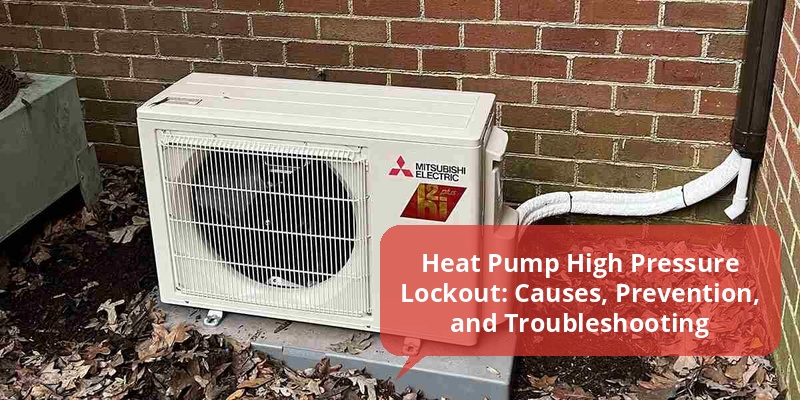Heat pumps are essential for efficient heating and cooling in American homes, but encountering a high pressure lockout can disrupt their operation. This safety feature protects the system from damage due to excessive pressure, but understanding why it occurs and how to address it is crucial for homeowners and HVAC professionals. This article explores the causes, prevention methods, and troubleshooting tips related to heat pump high pressure lockouts to ensure reliable and safe system performance.
| Aspect | Key Points |
|---|---|
| Definition | System safety response triggered by excessive refrigerant pressure |
| Common Causes | Dirty condenser coils, refrigerant overcharge, blocked airflow |
| Prevention | Regular maintenance, proper refrigerant levels, airflow management |
| Troubleshooting | Inspect coils, check pressures, reset system carefully |
What Is Heat Pump High Pressure Lockout?
Heat pump high pressure lockout is a safety mechanism designed to shut down the system if the refrigerant pressure rises beyond safe operating limits. This prevents potential damage to critical components such as the compressor and refrigerant lines. High pressure conditions often arise from issues like restricted airflow, contaminated coils, or improper refrigerant charge, which need urgent attention to restore normal operation.
Common Causes of High Pressure Lockout
Identifying the root cause of a high pressure lockout is crucial for effective troubleshooting and prevention. Some frequent causes include:
- Dirty or Blocked Condenser Coils: Accumulated dirt reduces heat dissipation, causing pressure buildup.
- Refrigerant Overcharge: Excess refrigerant increases system pressure beyond safe levels.
- Restricted Airflow: Obstructions such as blocked vents or dirty air filters limit air passing over coils.
- Faulty Expansion Valve: Malfunctioning or stuck valves disrupt refrigerant flow, increasing pressure.
- Mechanical Failures: Issues like compressor problems or sensor malfunctions may cause irregular pressure readings or system shutdowns.
How to Prevent Heat Pump High Pressure Lockout
Preventing high pressure lockout centers around system maintenance and monitoring. The following strategies help maintain safe operating pressures:
- Regular Cleaning of Condenser Coils: Schedule coil cleaning at least annually to improve heat exchange efficiency.
- Maintain Proper Refrigerant Levels: Ensure a certified technician checks and adjusts refrigerant charge according to manufacturer specifications.
- Keep Airflow Unobstructed: Replace air filters regularly and clear any blockages in vents and registers.
- Scheduled HVAC Inspections: Routine inspections detect early signs of mechanical issues that could elevate pressure.
- Use System Diagnostics: Employ pressure sensors and smart controls to alert users of abnormal pressure spikes.
Effective Troubleshooting Steps for High Pressure Lockout
Troubleshooting a heat pump high pressure lockout involves thorough inspection and careful system resets. Recommended procedures include:
- Turn Off the Heat Pump: Power down to prevent further damage during inspection.
- Inspect Condenser Coils: Clean any debris or dirt buildup to restore airflow and heat dissipation.
- Check Air Filters and Vents: Replace or clean filters and clear air pathways.
- Examine Refrigerant Levels: Consult an HVAC technician to verify proper refrigerant charge using gauges.
- Inspect Expansion Valve and Compressor: Identify mechanical failures or irregularities requiring professional repair.
- Reset the System: Follow manufacturer instructions to reset the high pressure lockout safely.
Repeated lockouts indicate a deeper system issue and should prompt a comprehensive service evaluation by a certified technician.
The Importance of Professional Maintenance
Regular professional maintenance ensures optimal heat pump performance and prevents high pressure lockouts. Certified HVAC technicians possess the expertise and tools to accurately diagnose and repair pressure-related problems. Moreover, proper refrigerant handling by licensed professionals complies with EPA regulations, protecting the environment and system health.
Signs Indicating Imminent High Pressure Lockout
Homeowners should be aware of warning signs that may precede a high pressure lockout:
- Unusual noises from the compressor or condenser
- Heat pump cycling on and off frequently
- Higher than normal energy bills due to inefficient operation
- Warm air blowing when cooling or cool air during heating cycles
- System displaying fault codes on the thermostat or control panel
Promptly addressing these symptoms can avoid costly repairs or system downtime.
Impact of High Pressure Lockouts on Heat Pump Longevity
Frequent high pressure lockouts place significant stress on heat pump components, accelerating wear and reducing lifespan. The compressor is particularly vulnerable, as excessive pressure leads to overheating and mechanical failure. By proactively managing pressure through maintenance and timely repairs, homeowners can enhance system durability and maintain energy efficiency.
Advanced Technologies to Mitigate High Pressure Issues
Recent advancements in heat pump design include smart sensors and pressure monitoring systems that enhance early detection of high pressure conditions. Automated shutoffs and remote alerts allow for quicker response and reduced risk of damage. Homeowners investing in technologically advanced heat pumps benefit from improved reliability and peace of mind.
Summary Table: Key Points About Heat Pump High Pressure Lockout
| Topic | Description |
|---|---|
| Purpose | Protect heat pump from damage caused by excessive refrigerant pressure |
| Main Causes | Dirty coils, refrigerant overcharge, blocked airflow, valve issues |
| Prevention Tips | Regular maintenance, clean coils, proper airflow, refrigerant checks |
| Troubleshooting | Inspect system components, check pressures, reset lockout, call professionals |
| Warning Signs | Unusual noises, frequent cycling, error codes, inefficient heating/cooling |
